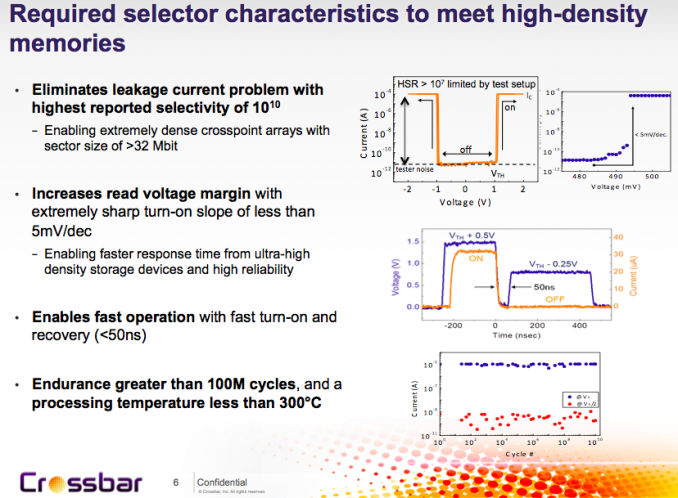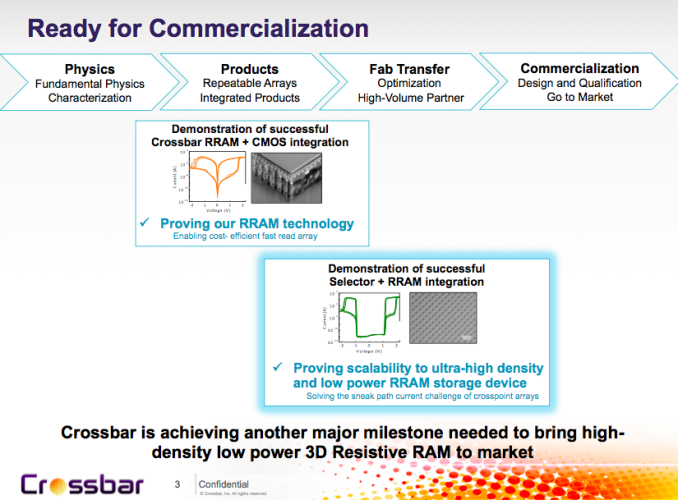Crossbar's Resistive RAM Technology Reaching Commercialisation Stage
by Kristian Vättö on December 21, 2014 4:35 PM EST- Posted in
- Storage
- SSDs
- Resistive RAM
- RRAM
- Crossbar

While the first 3D NAND chips have just found their way to the market and most NAND manufacturers are still developing their designs, there are already a handful of next generation memory technologies in development that are slated to supersede NAND in the next decade or so. One of the most promising technologies is Resistive Random Access Memory, which is more commonly referred to as Resistive RAM or just RRAM. Similar to NAND, RRAM is non-volatile, meaning that it will retain data without power unlike regular DRAM, which needs a continuous power source. Multiple companies are developing RRAM including semiconductor giants like Samsung and SanDisk, but Crossbar, a US based startup, has probably the most advanced design so far.
I've been following Crossbar for quite some time, but I haven't written anything about the company until now. The company was founded in 2010, headquarters in Santa Clara, California and has secured over $50 million in funding. The company's roots come from the University of Michigan and its Chief Scientist and co-founder, Prof. Wei Lu, is currently an associate professor at the university. The Crossbar team consists of 40-45 members at this point, of which most have extensive backgrounds in semiconductor research and development.
The big benefits RRAM have over NAND are performance and endurance. NAND read latencies are typically in the order of hundreds of microseconds, whereas Crossbar claims latency of as low as 50 nanoseconds for its RRAM design. Endurance in turn can be millions of program/erase cycles, although for the early designs Crossbar is aiming at more conservative ~100K cycles.
Last week at IEDM Crossbar announced that it is now entering the commercialization stage. In other words, it has already shown a working silicon and it has also proved that the design can be transferred to commercial fab for high volume manufacturing, so the company is now working with the fabs to build final products.
At first Crossbar is aiming at the embedded market and is licensing its technology to ASIC, FPGA and SoC developers with first samples arriving in early 2015, and mass production scheduled for late 2015 or early 2016. Aside from licensing, Crossbar is also developing standalone chips with higher capacity and density, which should enter the market about a year after the embedded RRAM designs (i.e.most likely sometime in 2017).
The beauty of RRAM is that it can be manufactured using a regular CMOS process with only a few modifications. NAND and especially 3D NAND require expensive special tools (for things like high aspect ratio etching), which is why only a handful of companies are making 3D NAND. RRAM in turn can be manufactured by practically any existing fab with very little added cost, which ultimately results in lower prices due to more competition.
Additionally, RRAM doesn't share NAND's lithography issues. As we know, the sole reason why 3D NAND was invented is because planar NAND can't really scale below 15nm without serious endurance and performance considerations. However, RRAM can efficiently scale to 4-5nm without any issues and in fact Crossbar has already demonstrated an 8nm chip that it built in its R&D labs (most likely using multiple patterning). Moreover, RRAM can be stacked vertically to create a 3D crosspoint array for increased density and so far Crossbar is at three layers, but first commercial standalone chips are expected to feature 16 layers and up to 1Tbit capacity.
Obviously, there are still several hurdles to cross before RRAM is ready to challenge NAND, but it's good to hear that there has been significant progress in development and the technology has gained interest from the fab companies. Faster, more durable and cheaper SSDs and other storage devices are a win for everyone and ultimately even 3D NAND is just an interim solution until something better comes around, which may very well be RRAM. I'll be doing a more in-depth article about RRAM technology in the coming months as this article was more of a heads up about the state of RRAM and Crosspoint's recent developments, so stay tuned for a deeper analysis!












65 Comments
View All Comments
Pork@III - Sunday, December 21, 2014 - link
This will be a new era of computer devices! I wait 2017 with great hope!
jjj - Sunday, December 21, 2014 - link
""Faster, more durable and cheaper SSDs and other storage devices are a win for everyone and ultimately even 3D NAND is just an interim solution until something better comes around, which may very well be RRAM"This phrase seems a bit misleading since 3D RRAM following 3D NAND has been the default scenario for some years now. Timing might be a bit unclear but timing always is.
Are you aware of any of the big NAND guys aiming for a different path as the default not just exploring other options? Guess maybe extending NAND's life with charge trap might be an option (maybe Spansion makes that work, or better said Cypress since they are merging).
Kristian Vättö - Monday, December 22, 2014 - link
I remain doubtful until RRAM is in high volume production by a major fab and is being adopted to mainstream products, and RRAM still has a long way to come before it reaches that state. While its physics are certainly alluring, there are all sorts of hurdles when it comes to mass production and scaling the design, so I don't want to be that sensational guy who says NAND is dead. Besides, you never know what happens in the next decade anyway -- some companies (e.g. Micron) haven't even revealed their next gen memory plans, which could be something other than RRAM (their roadmap lists next gen A and B technologies, so they seem to be developing more than just one tech).As for charge trap, Samsung has already deployed that in their 3D NAND design and we may see others following that path.
jjj - Monday, December 22, 2014 - link
As far as i know Micron is pretty much on the RRAM train ,they used to be less certain but i'm pretty sure that's the thinking now . Just a couple of years ago 3D RRAM was expected this decade by Sandisk for example. Now it seems it's getting pushed back a bit, it's always about costs but hopefully it will be less than a decade.Guess my point was that by not presenting it as being in a clear pole position, you make this news item seem like more than it is.
What i would like to know about Crossbar is what exactly would allow them to compete with the big guys or at least if they got enough IP to be bought by some Chinese entity ( China has no major player in RAM/NAND so they would be likely to try to get into that, it would be a big deal for us consumers since they would likely be aggressive and pricing would decline a lot more than with just the current players).
squngy - Monday, December 22, 2014 - link
The word memristor comes to mind.jjj - Monday, December 22, 2014 - link
And who is doing what there? HP and Hynix are doing RRAM with it.Jaybus - Monday, January 5, 2015 - link
They can be used in other than simple binary switch applications, such as IBM's neurosynaptic chips. See http://www.research.ibm.com/cognitive-computing/ne...MikhailT - Sunday, December 21, 2014 - link
Sounds too good to be true. What's the catch?sTITh - Sunday, December 21, 2014 - link
It only works when you lick it?LukaP - Sunday, December 21, 2014 - link
It will be expensice at first, since its an emerging technology, as was NAND at first